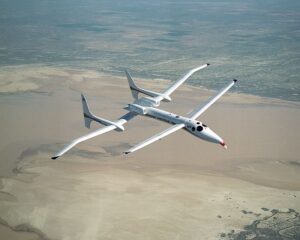26 July 1998 – Burt Rutan’s “Scaled Composites Model 281 Proteus is a tandem-wing high-altitude long endurance aircraft designed by Burt Rutan to investigate the use of aircraft as high altitude telecommunications relays. The Proteus is a multi-mission vehicle able to carry various payloads on a ventral pylon. The Proteus has an extremely efficient design, and can orbit a point at over 19,800 m for more than 18 hours. It is currently owned by Northrop Grumman.
 Proteus has an all-composite airframe with graphite-epoxy sandwich construction. Its wingspan of 77 feet 7 inches (23.65 m) is expandable to 92 feet (28 m) with removable wingtips installed. Proteus is an “optionally piloted” aircraft ordinarily flown by two pilots in a pressurized cabin. However, it also has the capability to perform its missions semi-autonomously or flown remotely from the ground. Under NASA’s Environmental Research Aircraft and Sensor Technology (ERAST) project, NASA’s Dryden Flight Research Center assisted Scaled Composites in developing a sophisticated station-keeping autopilot system and a satellite communications (SATCOM)-based uplink-downlink data system for Proteus’ performance and payload data. The Proteus wing was adapted for use on the Model 318 White Knight carrier aircraft, which is the launch system for Rutan’s Tier One spacecraft and the DARPA X-37.
Proteus has an all-composite airframe with graphite-epoxy sandwich construction. Its wingspan of 77 feet 7 inches (23.65 m) is expandable to 92 feet (28 m) with removable wingtips installed. Proteus is an “optionally piloted” aircraft ordinarily flown by two pilots in a pressurized cabin. However, it also has the capability to perform its missions semi-autonomously or flown remotely from the ground. Under NASA’s Environmental Research Aircraft and Sensor Technology (ERAST) project, NASA’s Dryden Flight Research Center assisted Scaled Composites in developing a sophisticated station-keeping autopilot system and a satellite communications (SATCOM)-based uplink-downlink data system for Proteus’ performance and payload data. The Proteus wing was adapted for use on the Model 318 White Knight carrier aircraft, which is the launch system for Rutan’s Tier One spacecraft and the DARPA X-37.
Flight testing of the Proteus began with its first flight on July 26, 1998, at the Mojave Airport and continued through the end of 1999. In June, Proteus was deployed internationally for the first time, debuting at the Paris Air Show. It was flown non-stop from Bangor, Maine to Paris. During the week-long show, it flew each day, demonstrating its capabilities as a telecommunications platform.
The Proteus is the current holder of a number of FAI world records for altitude (class: C1-e: landplanes 3,000–6,000 kg, Group: 3, turbojet), set in cooperation with NASA Dryden.[1] The highest altitude achieved was 63,245 feet (19,277 m) in October 2000.
Proteus was included in the list of the “100 Best of 1998 Design”, by Time magazine, December 21, 1998″(1)
Source: (1) Wikipedia
